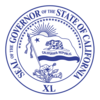It has been requested that the title of this article be changed to List of governors of California . Please see the relevant discussion on the discussion page. The page should not be moved unless the discussion is closed; summarizing the consensus achieved in support of the move. |

The Governor of California is the chief executive of the California state government, whose responsibilities include making annual State of the State addresses to the California State Legislature, submitting the budget, and ensuring that state laws are enforced. The governor is also the commander-in-chief of the state's military forces.

The Governor of California is the head of government of the U.S. state of California. The California Governor is the chief executive of the state government and the commander-in-chief of the California National Guard and the California State Military Reserve.

The government of California is the governmental structure of the state of California as established by the California Constitution. It is composed of three branches: the executive, consisting of the Governor of California and the other constitutionally elected and appointed officers and offices; the legislative, consisting of the California State Legislature, which includes the Assembly and the Senate; and the judicial, consisting of the Supreme Court of California and lower courts. There is also local government, consisting of counties, cities, special districts, and school districts, as well as government entities and offices that operate independently on a constitutional, statutory, or common law basis. The state also allows direct participation of the electorate by initiative, referendum, recall and ratification.
The State of the State Address is a speech customarily given once each year by the governors of each of the states of the United States. The speech is customarily delivered before both houses of the state legislature sitting in joint session, with the exception of the Nebraska Legislature, which is a unicameral body. The speech is given to satisfy a constitutional stipulation that a governor must report annually, or in older constitutions described as being "from time to time", on the state or condition of a U.S. state.
Contents
The current governor is Gavin Newsom, who has been in office since 2019.

Gavin Christopher Newsom is an American politician and businessman. He is the 40th governor of California, serving since January 2019. A member of the Democratic Party, he previously served as the 49th lieutenant governor of California from 2011 to 2019 and as the 42nd mayor of San Francisco from 2004 to 2011. He was sworn in as Governor of California on January 7, 2019.
Thirty-nine people have served as governor, over 40 distinct terms; many have been influential nationwide in areas far-flung from politics. Leland Stanford founded Stanford University in 1891. Earl Warren, later Chief Justice of the United States, won an election with the nominations of the three major parties – the only person ever to run essentially unopposed for governor of California. Ronald Reagan, who was president of the Screen Actors Guild and later President of the United States, and Arnold Schwarzenegger both came to prominence through acting. Gray Davis, the 37th governor of California, was the second governor in American history to be recalled by voters. The shortest tenure was that of Milton Latham, who served only five days before being elected by the legislature to fill a vacant United States Senate seat. The longest tenure is that of Edmund Gerald "Jerry" Brown, Jr., who previously served as governor from 1975 to 1983 and again from 2011 to 2019. He is the son of former governor Edmund Gerald "Pat" Brown, Sr. who served from 1959 to 1967.

Amasa Leland Stanford was an American tycoon, industrialist, politician, and the founder of Stanford University. Migrating to California from New York at the time of the Gold Rush, he became a successful merchant and wholesaler, and continued to build his business empire. He spent one two-year term as Governor of California after his election in 1861, and later eight years as a United States Senator. As president of Southern Pacific Railroad and, beginning in 1861, Central Pacific, he had tremendous power in the region and a lasting impact on California. He is widely considered a robber baron.

Leland Stanford Junior University is a private research university in Stanford, California. Stanford is known for its academic strength, wealth, proximity to Silicon Valley, and ranking as one of the world's top universities.

Earl Warren was an American jurist and politician who served as the 14th Chief Justice of the United States (1953–1969) and earlier as the 30th Governor of California (1943–1953). The Warren Court presided over a major shift in constitutional jurisprudence, with Warren writing the majority opinions in landmark cases such as Brown v. Board of Education, Reynolds v. Sims, and Miranda v. Arizona. Warren also led the Warren Commission, a presidential commission that investigated the 1963 assassination of President John F. Kennedy. He is as of 2019 the last Chief Justice to have served in an elected office.













































